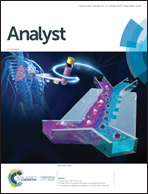The use of aggregation-induced emission probe doped silica nanoparticles for the immunoassay of human epididymis protein 4†
Abstract
A sensitive sandwich immunoassay for the sensing of human epididymis protein 4 (HE4) is developed based on aggregation-induced emission probe doped silica nanoparticles. Fluorescent silica nanoparticles (TSiO2) with excellent performance were prepared using a tetraphenylethylene based probe (TPE-C4-4) to produce a controlled aggregation effect, and HE4 was detected using antibody-functionalized fluorescent silica nanoparticles. The fluorescent silica nanoparticles possess good photophysical properties. The TSiO2 NPs were surface modified with carboxyl groups, and the antibody was covalently attached onto the surface of the nanoparticles. In addition, magnetic beads were modified with N-hydroxysulfosuccinimide sodium salt (NHS) on their surface, capable of forming stable peptide bonds with the antibody. TSiO2 NPs modified by an antibody and the magnetic beads modified by an antibody were used for the sandwich immunoassay for HE4 protein. The assay is quite sensitive and selective. The detection limit of HE4 is estimated to be 40 pM. The assay shows promising applications for the early diagnosis of ovarian cancer and the development of ovarian cancer-related drugs.



 Please wait while we load your content...
Please wait while we load your content...